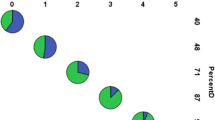Abstract
Social and demographic background variables relevant to male and female juvenile offenders were studied prospectively in a geographically defined population of 6,007 males and 5,757 females in Northern Finland, together with the distribution of offences by type and number between the sexes. Up to the age of 25 years, 532 males (8.9%) and 60 females (1.0%) had committed at least one crime leading to a criminal record. An intelligence quotient (IQ) of 50–84, but not below 50, was most closely associated with delinquency, as was school performance, in that not only was poor attainment associated with an increased incidence of delinquency, but above-average attainment was also predictive of a lower incidence. This is not interpreted as a causal association but rather an indication of similarity between the demands of the educational system and demands regarding socially desirable behaviour. The demographic, social, educational and health factors predictive of delinquency were very similar for males and females, and the reasons for the difference in the incidence of delinquency between the sexes must be looked for among the general differences in cultural demands and biological factors.
Similar content being viewed by others
References
Adler F (1981) International concern in light of the American experience. In: Adler F (ed) The incidence of female criminality in the contemporary world. University Press New York, pp 1–13
Afifi AA, Clark V (1990) Computer-aided multivariate analysis. Lifetime Learning Publications, Belmont, California
Berrueta-Clement JR, Schweinhart LJ, Barnett WS, Epstein AS, Weikart DP (1984) Changed lives. High/Scope Educational Research Foundation, Ypsilanti, Michigan
Box S, Hale C (1984) Liberation/emancipation, economic marginalization, or less chivalry. Criminology 22: 473–497
Cloninger CR, Reich T, Guze SB (1975) The multifactorial model of disease transmission. II. Sex differences in the familial transmission of sociopathy (antisocial personality) Br J Psychiatry 127: 11–22
Cullen FT, Golden KM, Cullen JB (1979) Sex and delinquency. Criminology 17: 301–310
Hartnagel TF (1982) Modernization, female social roles, and female crime: a cross-national investigation. Sociol Q 23: 477–490
Israelsson T (1990) Vad visar statistiken om kvinnor och brott? (What do the statistics tell us about females and crime?) In Wiklund G (ed) Kvinnor och brott. (Females and crime) Brå-rap-port 1. Allmänna Förlaget, Stockholm, pp 21–34
Järvelin M-R, Läärä E, Rantakallio P Moilanen I, Isohanni M (1995) Education, mental deficiency and juvenile delinquency. Except Child 61: 230–241
Johnson DR, Scheuble LK (1991) Gender bias in the disposition of juvenile court referrals: the effects of time and location. Criminology 29: 677–699
Kääriäinen J (1994) Seikkailijasta pummiksi. (From an adventurer to a bum) Vankeinhoidon koulutuskeskuksen julkaisuja 1/1994. Painatuskeskus, Helsinki
Offord DR, Boyle MH, Szatmari P, Rae-Grant NI, Links PS et al (1987) Ontario Child Health Study. II. Six-month prevalence of disorder and rates of service utilization. Arch Gen Psychiatry 44: 832–836
Offord DR, Boyle MC, Racine YA (1991) The epidemiology of antisocial behavior in childhood and adolescence. In: Pepler DJ, Rubin KH (eds) The development and treatment of childhood aggression. Lawrence Erlbaum Associates, Hillsdale, New Jersey, pp 31–54
Pasamanick B, Rogers ME, Lilienfeld AM (1956) Pregnancy experience and the development of behavior disorder in children. Am J Psychol 112: 613–618
Pösö T (1986) Naisesta naisvanki? Tutkimus naisten rikollisuudesta. (How a female becomes a female prisoner. A study of female criminality) Research Reports 83: 1–229, University of Tampere, Tampere
Rantakallio P (1969) Groups at risk in low birthweight infants and perinatal mortality. Acta Paediatr Scand [Suppl] 193: 1–71
Rantakallio P (1988) The longitudinal study of the Northern Finland birth cohort of 1966. Paediatr Perinat Epidemiol 2: 59–88
Rantakallio P, von Wendt L (1986) Mental retardation and subnormality in a birth cohort of 12000 children in Northernc Finland. Am J Ment Defic 90: 380–387
Rantakallio P, Koiranen M, Möttönen J (1992a) Association of perinatal events, epilepsy, and central nervous system trauma with juvenile delinquency. Arch Dis Child 67: 1459–1461
Rantakallio P Läärä E, Isohanni M, Moilanen I (1992b) Maternal smoking during pregnancy and delinquency of the offspring: an association without causation? Int J Epidemiol 21: 1106–1113
Rutter M, Tizard J, Whitmore K (eds) (1981) Education, health and behaviour. Robert E. Krieber Publishing Company Huntington, New York
Sampson RJ, Laub JH (1993) Crime in the making. Pathways and turning points through life. Harvard University Press, Cambridge Massachusetts London
Shoemaker DJ (1984) Theories of delinquency. An examination of explanations of delinquent behavior. Oxford University Press, New York
Statistical Yearbook of Finland (1991) Valtion Painatuskeskus, Helsinki
Statistical Yearbook of Finland (1992) Valtion Painatuskeskus, Helsinki
Statistical Yearbook of Finland (1993) Valtion Painatuskeskus, Helsinki
Steffensmeier DJ, Andersen AE (1988) Sex disparities in arrests by residence, race, and age: an assessment of the gender convergence/crime hypothesis. Justice Q 5: 53–80
Stott DH (1962) Evidence for a congenital factor in delinquency and maladjustment. Am J Psychol 118: 781–794
West DJ (1969) Present conduct and future delinquency. Heinemann Educational Books, London
West DJ, Farrington DP (1973) Who becomes delinquent? Heinemann Educational Books, London
White JL, Moffitt TE, Silva PA (1989) A prospective replication of the protective effects of IQ in subjects at high risk for juvenile delinquency. J Consult Clin Psychol 57: 719–724
Yearbook of Justice Statistics 1993 (1994) Statistics Finland, Justice 1994: 5, Helsinki
Author information
Authors and Affiliations
Rights and permissions
About this article
Cite this article
Rantakallio, P., Myhrman, A. & Koiranen, M. Juvenile offenders, with special reference to sex differences. Soc Psychiatry Psychiatr Epidemiol 30, 113–120 (1995). https://doi.org/10.1007/BF00802039
Accepted:
Issue Date:
DOI: https://doi.org/10.1007/BF00802039



